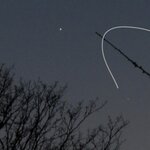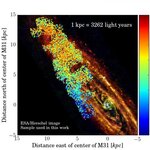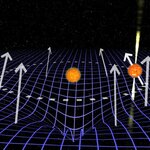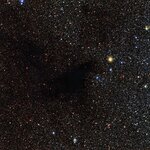Space

Yesterday (8th) I took this photograph of Venus and Mercury from the grounds of Reading University. In the photograph, Mercury is about two moon-breadths down and to the right of Venus. Over the next two days Mercury will follow the arrow relative to the much brighter Venus, moving up and closer to Venus, and then move off to the right. For folks in the USA, you should get a slightly better view as the angles will be tilted a few degrees clockwise, and near the Equator the two planets will appear to sit directly over the brightest part of the sky where the sun is directly…

By studying the motions of different stellar populations in the disk of the Andromeda galaxy, researchers have deduced that Andromeda has had a more violent past than our Milky Way.
The structure and internal motions of the stellar disk of a spiral galaxy hold important keys to understanding the galaxy's formation history. The Andromeda galaxy, called M31 by almost no one except the 2 percent of astronomers who like to insist on renaming and reclassifying things, is the closest spiral galaxy to the Milky Way and the largest in what is called the Local Group of galaxies in our cosmic…

In an interstellar race against time, astronomers measured the space-time warp in the gravity of a binary star and determined the mass of a neutron star just before it vanished from view.
The researchers measured the masses of both stars in binary pulsar system J1906. The pulsar spins and emits a lighthouse-like beam of radio waves every 144 milliseconds. It orbits its companion star in a little under four hours. The mass of only a handful of double neutron stars have ever been measured, with J1906 being the youngest. It is located about 25,000 light years from Earth.
…

In a new ESO image of LDN 483 and its surroundings, located about 700 light-years away in the constellation of Serpens (The Serpent), some of the stars are missing.
But it's not a portent of doom, it's space pollution - gas and dust are obscuring Lynds Dark Nebula 483. LDN 483 and its dark cloud are intriguing because such clouds are the birthplaces of future stars.
LDN 483 [1] contains enough dusty material to completely block the visible light from background stars. Particularly dense molecular clouds, like LDN 483, qualify as dark nebulae because of this obscuring property. The…

Artist's impression of an Earth-sized planet in the Kepler 186 system. But what makes one planet more habitable than another? NASA Ames/SETI Institute/JPL-Caltech
By Jonti Horner, University of Southern Queensland; Belinda Nicholson, University of Southern Queensland, and Brad Carter, University of Southern Queensland
When it comes to finding the right kind of planet to target in the search for life elsewhere in the universe, the size of the planet matters.
All planets are believed to form by a process of competitive cannibalism, in a disk of material around a nascent star. Small pieces of…

How might you make a new Earth? Our Terran "test kitchen" has given us a detailed recipe, it just wasn't clear how transposable it was in other areas, the same way a recipe in Los Angeles might not work as well in Denver. Now, astronomers have found evidence that the recipe for Earth also applies to terrestrial exoplanets orbiting distant stars.
"Our solar system is not as unique as we might have thought," says lead author Courtney Dressing of the Harvard-Smithsonian Center for Astrophysics (CfA). "It looks like rocky exoplanets use the same basic ingredients."
The key to the discovery was…

NASA’s Opportunity Mars rover, also known as "Oppy", is continuing its traverse southward on the western rim of Endeavour Crater despite computer resets and "amnesia" that have occurred after reformatting the rover's flash memory. The problems have forced the controllers to switch the robot to a working mode that avoids use of the flash data-storage system. In the no-flash mode, the rover can continue normal operations of science observations and driving, though it cannot store data during the overnight sleep. The good news is, the restoring of the rover's flash memory will begin soon. “…

Artist’s impression shows a sunset seen from the super-Earth Gliese 667 Cc. The brightest star in the sky is the red dwarf Gliese 667 C, which is part of a triple star system.
The other two more distant stars, Gliese 667 A and B appear in the sky also to the right. Astronomers have estimated that there are tens of billions of such rocky worlds orbiting faint red dwarf stars in the Milky Way alone. Credit: ESO/L. Calçada
By Brad Carter, University of Southern Queensland; Belinda Nicholson, University of Southern Queensland, and Jonti Horner, University of Southern Queensland
Ever since humans…

On Dec. 10th, ESA announced the latest important discovery regarding comet 67P/Churyumov–Gerasimenko. Rosetta spacecraft orbiting the comet has found the water vapor from its target to be significantly different to that found on Earth.
The discovery made by Rosetta Orbiter Spectrometer for Ion and Neutral Analysis (ROSINA) fuels the debate on the origin of our planet’s oceans. That’s not all, ESA’s Rosetta project scientist, Matt Taylor, believes that ROSINA will make more key findings for our understanding of the origin of life. “ROSINA is continuing to take measurements and will for the…

Our Milky Way is part of a cluster of more than 50 galaxies that make up the ‘Local Group’, a collection that includes the famous Andromeda galaxy and many other far smaller objects.
And now one more, a tiny and isolated dwarf galaxy almost 7 million light years away, named KKs3. KKs3 was found using the Hubble Space Telescope Advanced Camera for Surveys (ACS) in August 2014 in the southern sky in the direction of the constellation of Hydrus and its stars have only one ten-thousandth of the mass of the Milky Way.
Kks3 is a ‘dwarf spheroidal’ or dSph galaxy, lacking features like the spiral…